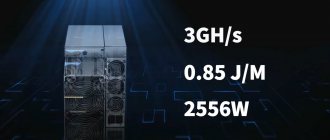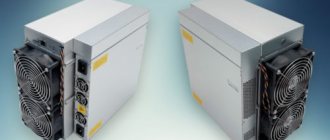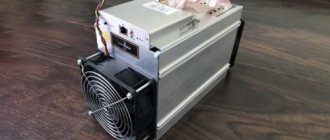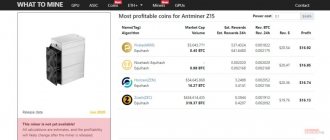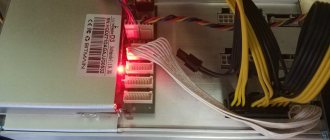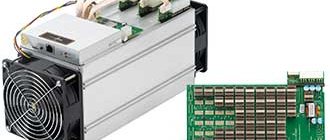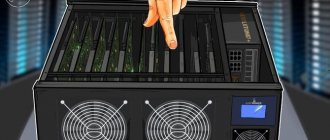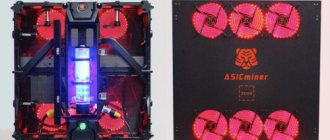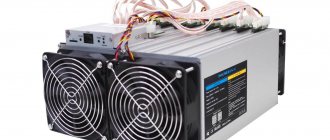Review of the heirs of the legend - Antminer S9 SE and S9k
The launch of the Antminer S9 coincided with the colossal rise of the Bitcoin cryptocurrency in 2022, which led to never-before-seen highs of $19,783. Like Bitcoin, the Antminer S9 has remained a strong part of the cryptocurrency industry ever since.
During the period of sharp growth in mining activity until 2017, the hardware struggled to keep up with the complexity of the algorithm, while many miners joined the industry at a rapid pace.
The launch of Antminer S9 in May 2016 improved existing models by up to three times, marking a change in increasing hash rates without compromising power efficiency.
Capable of mining cryptocurrencies using the SHA256 algorithm at 14 TH/s, the S9 quickly came to dominate the crypto mining industry, with each batch selling out within hours. This allowed for a significant increase in ROI that was unmatched by other miners.
Recent sales have shown that Antminer S9 remains in demand to this day.
In fact, Antminer S9 is still one of the most popular miners. It was the world's first Bitcoin cryptocurrency miner using a powerful 16nm chip, one of the most powerful chips that is still installed in the most energy-efficient cryptocurrency miners in the world today.
The release of the new generation of Antminer S9 models marks an excellent opportunity to evaluate the progress made since the first S9 hit the market.
Technical characteristics of Antminer S9
Among the parameters it is necessary to highlight:
- Hashrate – from 13 to 14 TH per second (depending on modifications);
- energy consumption – from 1350 W to 1450 W for different modifications, increases by 5-7% at room temperatures above 25 °C;
- voltage – 11.6-13 V;
- energy efficiency – 0.098 JGH;
- equipped with 189 BM1387 chips with a clock frequency of 550-650 MHz;
- Ethernet network interface 1 Gbit per second;
- operating temperature – 0-40 °C;
- Dimensions – 350 x 135 x 158 millimeters.
BM1387 chips are based on the 16 nm process technology, and Antminer S9 might seem late to the market, since it came out later than competing ASICs with chips on this process technology. However, the developers delayed it because they wanted to release a completely finished device that would avoid all “childhood diseases.”
And the result lived up to expectations: the power almost tripled compared to the previous model (from 4.7 TH per second), energy efficiency increased 2.5 times - as a result, even a year and a half after its release, the device continues to be in demand.
Pros and cons of Antminer S9
If we talk about the advantages of the S9, then first of all it is worth highlighting the following points:
- Still relevant for 2022 (even despite the greatly increased difficulty of Bitcoin mining + a huge drop in the cryptocurrency rate).
- Decent power, taking into account the ratio of hashrate, power consumption and cost of the device.
- Bitcoin mining - algorithm]SHA-256[/anchor] is still considered the most promising and profitable due to the status and weight of Bitcoin.
- The cost of ASIC has dropped significantly compared to 2016 and even 2017, so the device can be found at a bargain price.
There are also disadvantages of the device, although most of them can be considered conditional. They mainly concern the obvious features of many ASICs, which have retained their relevance by 2018. This concerns high power consumption and noise.
However, if you are not going to keep the S9 in living rooms, having allocated a special room for this (as is customary to do in most cases), noise can be called a conditional drawback. Moreover, at the moment, only a few models on the market can boast of moderate operating noise, so this minus applies to all ASICs rather than specifically to the S9.
Another disadvantage is the need to use an additional power supply. The installed power supply often overheats, especially when working on exchange pools (for example, NiceHash). Any server power supply will be suitable for these purposes.
It is also worth considering that when starting an ASIC (especially if it was bought secondhand, which is usually not recommended), you need to check:
- Power – the indicator should not be lower than 13.5 TH/s.
- No chip errors (in the Asic Status window, errors will be displayed as “X” instead of “0”. All chips should show “0”).
- Fan speed – basically, this indicator depends on the overall temperature in the room, so you shouldn’t pay much attention to this point (only if the ASIC is in hot rooms, which is undesirable).
Appearance and interfaces
The S9 looks similar to previous ASICs from this manufacturer: the same elongated body, ending with coolers on both sides. Thanks to this design, it is perfectly possible to “blow” heat out. On the sides of the body there are ribs for connecting several miners into a farm.
On top there is a network controller and indicator lights. There is a slot for an SD card, which will be needed to flash the miner if the need arises. Inside the device there are three boards with chips, all of them are equipped with radiators covering each chip on both sides. Cooling is a sore point for this model: the manufacturer was forced to slightly reduce the frequency of the processors, and therefore the hashrate, due to the fact that the device overheated, but the fans were installed even too powerful, and the problem was that they were not operating efficiently enough. Moreover, they make a lot of noise, and therefore, if the room is not hot, their rotation speed can be reduced to 60-70% of the default setting.
The S9 is configured and managed using the web interface from Bitmain, which is famous for its convenience and breadth of capabilities: thanks to the competent interface, managing the device is very simple. You will be provided with all the information about temperature, hash rate and other important aspects of the ASIC operation, you can get both information at the time of the request and a statistical summary for comparison. In addition to the web interface, the device’s status can be monitored using a smartphone by installing an application from the manufacturer on it.
Opening a new chapter
With the Antminer S9 in high demand, Bitmain has continued to work on making this model more efficient and affordable than ever.
Both the new architecture and design were introduced for the S9 Special Edition (SE) and S9k models and delivered increased performance while being more energy efficient. The S9k hashes at a rate of 13.5 TH/s, with an outstanding power efficiency of 85 J/TH.
The Antminer S9 SE goes one step further by delivering a hash rate of 16 TH/s while achieving an even higher power efficiency of 80 J/TH and weighing only 4.5 kg, making it the most energy efficient of the Antminer S9 series
The first model of the original Antminer S9 with its hash rate of 14 TH/s remained revolutionary at that time, but its energy efficiency, so to speak, was 100 J/TH, so the first Antminer S9 consumed 15-20% more energy, which ate up mining profits.
Of course, miners with access to cheaper electricity or renewable energy sources receive noticeably more net profit. But it is worth noting that the noticeable improvements to the standard in the Antminer S9 series, set by the once revolutionary S9 and which will be constantly improved, further increase the profitability of miners.
In a rapidly evolving space like cryptocurrency mining, engineers never know where research developments will take them, so it's always exciting to introduce a new and improved product to the mining community.
And as new mining tools continue to be developed and improved, it is important to preserve the legacy of the models that paved the way for it.
Watch Antminer S9 SE and Antminer S9k in the bitmain.rf store
Features of Antminer S9
The ASIC contains three hash boards, each with 63 BM1387 chips. The chips have a clock frequency of 600-650 MHz and performance of up to 4.7 GH per second. In total, they provide a considerable hashrate, even by the standards of 2022, for mining using the SHA-256 algorithm, which allows you to mine coins such as Bitcoin (BTC) and Bitcoin Cash (BCH), as well as a number of less popular and profitable ones.
The manufacturer has squeezed everything it can out of the model, and there is both good and bad in this. It is distinguished by stable and high-quality work, and compared to its predecessors it has significantly improved in many components. At the same time, miners often use such an option as overclocking, because the effectiveness of ASICs is fairly limited, and they want to get as much profit as possible while they can. Unfortunately, in this case, overclocking is extremely limited.
Bitmain squeezed almost all megahertz out of the chips, and while their other devices can sometimes be overclocked quite well, and most of them can at least achieve an increase of 10%, then it’s difficult to count on this with the S9. The frequency of 650 MHz, at which the first copies operated, was almost the limit of stable operation, but if you got one of the last ones with a frequency of 550 MHz, then a certain reserve will appear. If you raise the frequency above 650 MHz, then the performance will quickly begin not to increase, but to fall - already at 675 MHz it decreases 10 times.
Bitcoin mining experience with Antminer S9
The device is designed for mining cryptocurrencies using the SHA-256 algorithm; the main cryptocurrencies based on this algorithm are Bitcoin and Bitcoin Cash.
The ASIC produces 14TH/s and consumes 1300W, earlier S9s had less power, there were versions with 12.5TH/s, 13TH/s, 13.5TH/s, of course, and they consumed a little less from the outlet.
At the moment, devices can be purchased at prices ranging from 150,000 rubles for used 12.5TH/s to 180,000 - 220,000 rubles for new 14TH/s. Reseller prices in Russia, Europe and the USA are not particularly different.
After unpacking the device, you need to connect it to the Internet via a regular cable and plug it into an outlet. Now open the browser and enter the device’s IP.
We enter the default password and login and get into the ASIC settings.
On the General Configuration tab, enter the data of the pool we have selected, in our case it is Antpool (owned by Bitmain). You can enter 3 servers of the same pool or enter 3 different pools. If the first pool does not respond, the device will work with the second.
Save the settings and MAGIC begins. The device thinks for about 5 minutes, and then starts spinning the fans to their fullest. It feels like we are sitting on the wing of a plane taking off. Two impressive fans create a very loud noise; you won’t be able to work indoors, much less live with an ASIC, these are not video cards... You can replace the fans with quiet models - this will cost about 3,000 rubles.
We look at the Miner Status tab... mining has begun. We can see how much TH/s each board provides, how much the device outputs in total, and the temperature of each board. There are a total of 3 boards with chips in the device; if one fails, the other two continue to work, but TH/s will be less. ASIC status shows us the status of the boards, everything 00000 is good, xxxxx you have problems.
You can update the device firmware by getting a new one from Bitmain.com. Adjust the fan speed, and even overclock the device at your own peril and risk.
We go to the pool interface and monitor our two devices. If everything is good, the pool will show the hashrate of each device.
You can view charts by hour or day. The hashrate fluctuates, sometimes 13TH/S, and sometimes 17TH/s is shown by the pool statistics, but you cannot influence this in any way. On average per day it turns out to be 13.7TH/S
The pool has different reward systems for miners. Payment for each share (a possible solution), payment depending on the luck of the pool (your participation in the shares is calculated as a percentage, and a percentage of the pool's income is paid) and, of course, SOLO (searching for a block alone). There is also an interesting setting - AUTO switching between Bitcoin and Bitcoin Cash mining (the pool itself decides which is more profitable), while payments will be made in Bitcoins.
We use the second system and in recent days our income from two devices has been 0.0085 BTC per day or 35 US dollars (Bitcoin rate $4,189). According to What to Mine we should receive 0.0078 BTC per day, and Nicehash predicts 0.0077 BTC per day. We must understand that the pool finds a different number of blocks every day, and our reward can be either higher or lower.
Antpool pool capacity today is 1190 PH/s. We are just a small drop in this ocean. Although, sometimes it is interesting to see how often the pool finds blocks. The screenshot above will give you an idea of the reward for finding a block in the Bitcoin network. 12.5 BTC + commissions for transactions in the block. Maybe it's worth setting our miners to look for a block in SOLO? If we find 1 block, we will be rich... although the probability, of course, tends to zero. In the pool statistics, by the way, you can see people who, with 1-2 machines, persistently search for blocks in SOLO.
To summarize, the payback period for the device is currently 7-9 months. If we keep our Bitcoins and do not sell them, then, perhaps, with an increase in the rate, the payback will drop to several months, although, you understand, the opposite situation is also possible.
PS “Mining will die” can be heard from all sides, and we answer you with a FACT:
Antminer S9 began to be released in June 2016.
To safely sell and buy mined cryptocurrency, we recommend a Telegram bot. Read the overview and details of the work in this article.
If you want to receive the latest information about ASIC, then subscribe to our Telegram channel.
Connection and setup
Install the ASIC so that there is a gap between its rear fan and the wall, otherwise the device will be at risk of overheating. The device can be supplied either with or without a power supply. It is better to choose the option with it, since overclocking this ASIC is not very profitable, and the power supply from the manufacturer is of high quality, and you will not have problems because of it: its power of 1.6 kW is enough to power the S9, it provides a voltage of 12 V , and the efficiency is 93%.
The PSU also has a cooler, since the circuitry requires cooling, and this is the only drawback of the device. This cooler also creates quite a bit of noise, noticeable even compared to the noise from the S9. However, this defect is inherent only in earlier versions; in more recent versions the problem has been solved.
If there is only one ASIC, then the device can be easily connected to an outlet, but if you are installing a cluster, you will need a separate circuit with thick wires: for example, for five such ASICs you need 32A, which is twice as much as in a standard household outlet.
Electricity is supplied, the S9 turns on - and already in the first seconds of startup you can feel that this is a really powerful unit, judging by the hum of the fans. This noise immediately makes it clear that this ASIC has no place in a residential apartment. The noise can reach 75 dB, which will create uncomfortable conditions for living nearby. There are light indicators on the front panel of the device: green lights up normally, while red indicates an error. After switching on, the red light may light up for several minutes - this is a normal situation; after a minute or several, the state of S9 should return to normal.
When everything is ready, we find out the IP address, for which there is a special button on the control panel. After this, the IP, login and password are entered in the browser. The web interface is simple and clear, through it you can update the firmware, configure the connection, assign a permanent IP to the device, set the speed of the coolers, and so on. To start mining, you need to register in the pool. The stratum protocol is used, which narrows the choice: Antpool and F2pool will be available, in other cases failures are possible. The first one was created by the ASIC manufacturer itself, and we recommend it.
After mining starts, you should leave the device for a while. After about an hour, it will become clear how well it does its job. A deviation within 5% in any direction from the hashrate declared by the manufacturer will be considered normal.
If you do install an ASIC in your apartment, then at least you should allocate a separate room for it, but even then the fans will make a lot of noise. The problem can be solved by replacing them - its cost compared to the price of the device itself is small: server fans of the required power cost about 1000 rubles.
Moreover, 4000 rpm is enough - the original fans do not work efficiently, and a high-quality replacement, even at a lower number of revolutions, will also reduce the temperature of the S9. And most importantly, the noise will be significantly reduced. Moreover, if you buy something more expensive with well-designed aerodynamics of the blades, then it will even be possible to install the device in the living room.
Performance, by the way, directly depends on the temperature: it is desirable that the room is approximately 20 °C, then the board will warm up to 50 °C, and the chips will warm up to at most 80 °C, and performance will be maximum. If the temperature of the board and chips becomes 5° higher, performance will drop by 5% due to an increase in the number of errors - a little, but unpleasant. Well, it is categorically undesirable to allow an even greater increase in temperature, since it is fraught with failure of the ASIC.
Evolution: Steps in the evolution of the S series
At the peak of cryptocurrency growth, Bitmain engineers did a lot of work to improve the performance of Antminer S9.
The team managed to release the Antminer S9i just a year later in May 2018, followed by an improved version of the Antminer S9j just a few months later in August 2022. Each model offered an improved hash rate of 14.5 TH/s while achieving lower power consumption.
During the same period of time, Bitmain began experimenting with more environmentally friendly means of running and cooling miners with the Antminer S9 Hydro and its water cooling system. It could operate at a hash rate of 18 TH/s while maintaining lower noise levels and an improved cooling mechanism.
During this period of intense growth, it was important that the mining community received the best technology available, without being overwhelmed by the long-term and complex developments of the entire industry.
Advantages and disadvantages of Antminer S9
The advantages of this ASIC are the following:
- high level of productivity;
- good energy efficiency parameters;
- relatively modest size;
- autonomy, presence of installed Linux;
- easy installation and configuration;
- high-quality power supply providing a high level of efficiency;
- ease of joining into a cluster.
It also has several disadvantages:
- noisy and inefficient fans; if the S9 is used in a residential area, it is highly advisable to replace them;
- small selection of pools;
- poor-quality hot-melt adhesive; chips may fall off due to overheating;
- weak overclocking potential.
The shortcomings are not so critical, and are mostly eliminated at low cost; of course, it would be better if the manufacturer managed to do without them altogether, but they cannot significantly affect the positive assessment of the S9.
Setting up the mining process
You can mine cryptocurrencies even with standard settings, the main thing is that there are no problems with the network connection. However, in any case, the main task of each user is to set personal settings. If you haven’t registered for the pool before, now is the time to do it.
Integrated circuits from Bitmain operate on a modified Startum protocol, so you can join Chinese associations like Antpool or F2pool without any difficulty. The manufacturer does not guarantee compatibility with other pools.
There will be no problems registering with Antpool, especially considering that the official pool portal is partially translated into Russian. After filling out the registration form, you will be redirected to your personal account. To log in to the pool, you need to create a mining account. In the future, this particular account will need to be registered in the settings, so copy it.
To synchronize the miner and account, open the page with pools and insert the account name into the appropriate line; you do not need to change the password.
It is better to leave the checkbox in the “Stop running when temperature is over 80” field, because if the equipment starts to overheat, it will turn off automatically as a result. Chips can withstand temperatures of 100 degrees, but it’s still not worth testing their capabilities. The optimal temperature is up to 50 degrees. You can set the rotation speed of the radiators a little lower.
Clock purity can be set in the “Advanced Settings” section. On average, the optimal value varies in the range of 600-650 MHz. To overclock Antminer S9, connect one of the boards to another power supply, since the “native” adapter has a minimum power reserve.
At the moment the set parameters are saved, the cryptocurrency mining process will be restarted. To view the statistics, go to the “Miner Status” menu.
You need to monitor not only temperature and performance, monitor the number of chip errors, as well as the number of hashes not accepted; the values of these parameters should be kept to a minimum. What internet speed is needed for the Antminer miner? For the average user, 2-3 MB/s will be enough.
